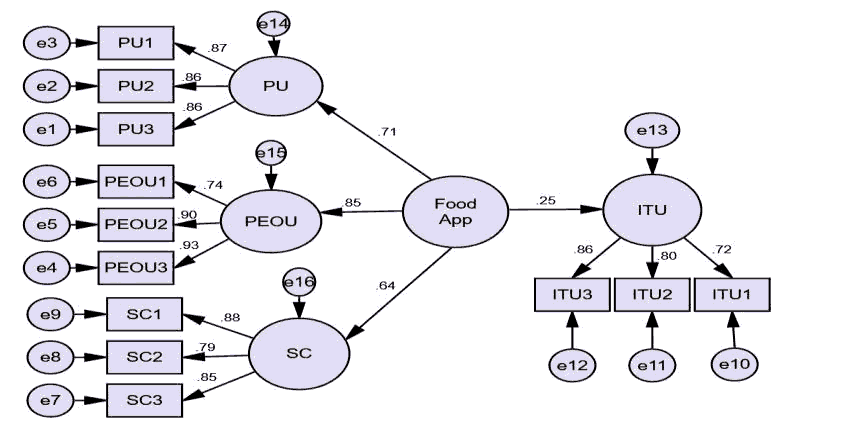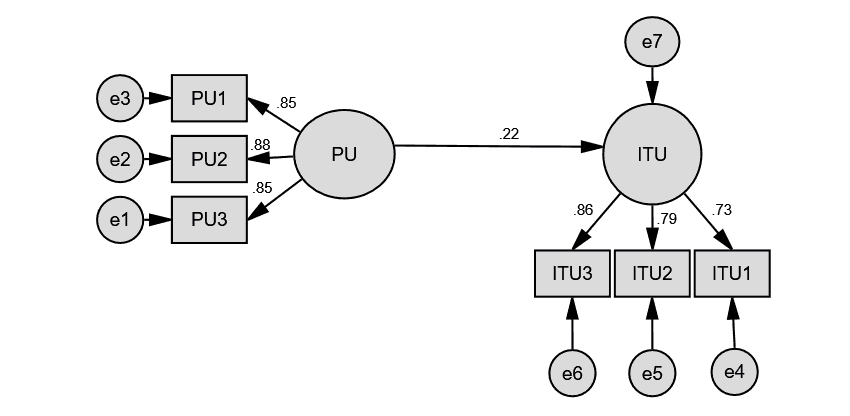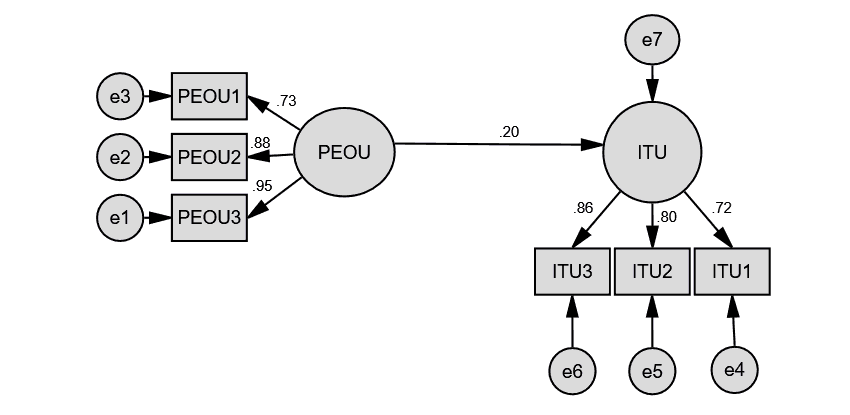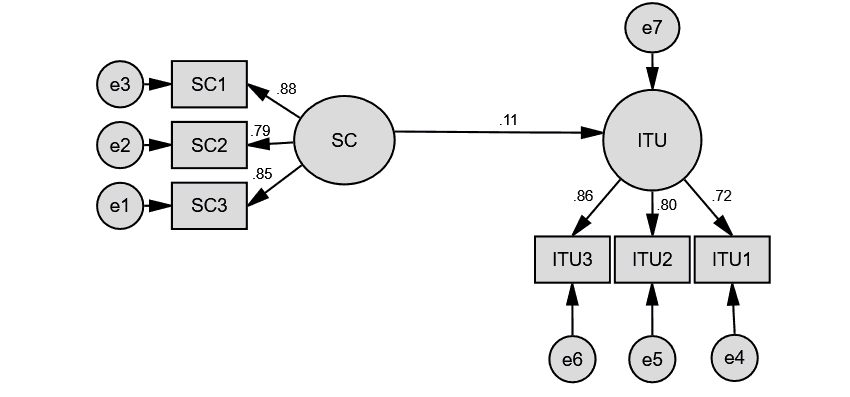Research Article: 2021 Vol: 27 Issue: 5S
Food Delivery Apps: Intention to Use During Covid-19
Ruchi Gupta, Shaheed Bhagat Singh College, University of Delhi
Kiran Nair, Abu Dhabi School of Management
Keywords:
Food Delivery App (FDA), Perceived Usefulness, Perceived Ease of Use, Safety Concerns, COVID-19
Abstract
The online food delivery industry in India is growing due to the changing lifestyles, eating habits of people, their busy work schedules and increased disposable income, particularly in urban areas of the country. Our research investigates how people used food delivery apps (FDAs) during the COVID-19 outbreak in India. The study particularly aims to determine the influence of the safety concerns of people on the intention to use FDAs during the COVID-19 outbreak. The factor structure of our research model was confirmed using exploratory factor analysis. The model's validity was tested using confirmatory factor analysis. Structural equation modelling was used to measure the intention to use the FDA. Results revealed that perceived usefulness and perceived ease of use had a positive and substantial impact on intention to use a FDA. However, people's safety concerns about dining out versus ordering food at home were found to have no effect on their intention to use the app. In simple words, customers will use a FDA if it offers a variety of food options, quick navigation through the numerous food options, restaurants, and convenience of food selection and transaction processing. Not only that, but the study claims that another motivation for people to use a FDA is to relieve themselves from cooking so they can spend their time on other work or leisure activities, as well as to acquire a variety of meals while sitting at home without having to cook the same. Our research adds to the body of knowledge about the usage of FDAs during the COVID-19 outbreak. It also examines the implications in terms of key features of a FDA and important elements in designing such an app.
Introduction
The online food delivery sector in India is rising in sync with Indians' changing lifestyles and eating habits. Food delivery has become increasingly popular, especially in urban areas, as a result of hectic work schedules and rising disposable income. Over the years, a plethora of online Food Delivery Apps (FDAs) have sprung up all over India. Ordering restaurant food using mobile apps has become the new craze among urban middle-class Indians. Aggregators like Swiggy and Zomato are strong players in the Indian online food delivery sector.
The growing adoption of FDAs in India can be attributed to a variety of causes. The usage of different mobile apps, including food delivery apps, has risen as a result of an affluent middle-class population with increasing purchasing capacity and mobile apps playing a vital lifestyle component for the majority of the population. In addition, the number of working women in the Indian workforce has increased in recent years, particularly in the urban sectors/city-based industries. As a result, the number of households with two incomes is rising. People find it challenging to find time and energy to cook at home when both spouses work and have busy work schedules. As a result, people are increasingly preferring to buy food online and enjoy their favourite cuisine at home for a reasonable price.
The benefits offered by FDAs attract new customers. FDAs provide customers with virtually anything they require at the press of a button. Customers are not required to leave the house or call the restaurant to place an order. Customers may use these apps to discover all local restaurants, examine menu selections, and order food or beverages (Prasetyo et al., 2021; Kapoor & Vij, 2018).
Our research aimed to learn more about how individuals in India used FDAs during the COVID-19 pandemic. Our study seeks to determine the influence of these safety issues on the intention to use FDAs, particularly in light of people's rising safety worries due to the spread of virus and the potential danger of infection when dining outside.
Literature Review
Technology Acceptance Model -TAM (Davis, 1986)
The Technology Acceptance Model (TAM) was developed by Davis (1986) in the context of analysing customer acceptance of technologies. The model identifies the two most critical factors influencing a person's decision to use technology as ‘perceived usefulness’ and ‘perceived ease of use’.
Perceived Usefulness (PU) is the user's anticipation that the technology will make his or her job easier, whereas Perceived Ease of Use (PEOU) is the user's expectation that utilising the technology would be easy (Davis, 1989).
As a result, we employ the constructs of ‘perceived usefulness’ and ‘perceived ease of use’ to define the benefits of a food delivery app (the technology in question) in our research model. In addition, because our research is focused on the use of FDAs during COVID-19, we take into account one more factor that will influence the decision to use a FDA. The ‘safety concerns of people during the COVID-19 pandemic' is characterised as this construct. As a result, the study proposes the following hypothesis.
H1: Benefits of a food delivery app during COVID-19 have a significant and positive impact on the intention to use the app.
Perceived Usefulness of a Food Delivery App
As a result of urbanisation, people have become busier with hectic schedules and work life. They have limited time to prepare food (Chai & Yat, 2019). As a result, people are increasingly using FDAs to save time and effort of cooking food at home or going out to eat. Factors such as convenience of time and effort impact people's attitudes toward FDAs (Collier & Kimes, 2013).
H2: Perceived usefulness of a food delivery app has a positive and significant impact on intention to use the app
Perceived Ease of Use of a Food Delivery App
People in the modern digital world have discovered that ordering food via a FDA is simple and quick. The FDA’s ease of use can be measured in terms of providing consumers with a variety of food options, easy navigation through those options, and the ease of food selection and transaction processing (Suhartanto et al., 2019). Thus, we propose the following hypothesis.
H3: Perceived ease of use of a food delivery app has a positive and significant impact on intention to use the app.
Safety Concerns due to COVID-19
Several restaurants that did not meet safety requirements were forced to close during COVID-19 due to widespread societal restrictions. To limit the danger of COVID-19 exposure, restaurants that are permitted to open must follow social distance standards. Even while restaurants currently follow strict social distancing standards, there is always a risk that people will become infected. Using an online FDA to help prevent the spread of COVID-19 is a possible solution to help stop the virus from spreading in restaurant settings (Prasetyo et al., 2021).
H4: Safety concerns due to COVID-19 have a positive and significant impact on intention to use the food delivery app
Research Methodology
Questionnaire
There were two parts to our survey. The first section comprised of questions about respondents' demographic profiles. The second section of the questionnaire included statements on the Likert Scale to assess the study's constructs: Perceived Usefulness (PU), Perceived Ease of Use (PEOU), Safety Concerns during COVID-19 (SC), and intention to use the food delivery app (ITU). There were a total of 12 items for which responses were gathered on a 7-point Likert Scale ranging from "Strongly Disagree" (point 1) to "Strongly Agree" (point 7). Table 1 lists the factor items used to assess the study's constructs.
| Table 1 Items of Constructs |
||
|---|---|---|
| Constructs | Construct Items | Source |
| PerceivedUsefulness (PU) | PU1: I feel that a food delivery app helps me to save time by ordering food insteadof cooking food myself PU2: I think that using a food delivery app can reduce my travel effort to buy foodand beverages PU3: A food delivery app helps me to enjoy different variety of food at theconvenience of my home |
Yeo, et al., (2017); Prabowo & Nugroho, 2018 Prasetyo, et al., (2021) Authors of this study |
| Perceived Easeof Use (PEOU) | PEOU1: I can easily find things/food items in food delivery app PEOU2: I find that the food delivery app has search button to help me in my searches PEOU3: I can complete a transaction without much hassle |
Adapted from Suhartanto, et al., (2019) |
| Safety Concernduring COVID-19 (SC) |
SC1: I amafraid to dine in a restaurant due to COVID-19 pandemic SC2: I understand about social distancing regulations, so I chose to use a fooddelivery app instead of dining in a restaurant SC3: I think that ordering through a food delivery app is a solution to limitedseating capacity in a restaurant due to social distancing regulations |
Adapted from Prasetyo, et al., (2021) |
| Intention toUse (ITU) | ITU1: I plan to use food delivery app frequently/regularly ITU2: I plan to use food delivery app for ordering food items during COVID-19 ITU3: I plan to use food delivery app in future also |
Adapted from Lee, et al., (2019) |
Sample
Responses were gathered from 339 people by sending online surveys to over 700 people in Gurgaon, a city in India's Delhi/NCR region with a large population of young working professionals. As a result, our sample originates from a location where individuals lead hectic lives. Non-probability sampling is the method we used to collect the sample. The survey's qualifying question was if the respondent used a FDA. People's responses were taken during the month of March 2021, when complete and partial lockdown conditions in India were lifted, although there were still concerns about safety owing to the COVID-19 pandemic. The demographic profile of our respondents is shown in Table 2. Table 2 shows that our sample has an equal representation of people of different ages. Our sample, however, is primarily representative of people in the middle and upper middle income brackets.
| Table 2 Demographic Profile of the Respondents |
|||
|---|---|---|---|
| Demographic Factors | Category | Number of respondents | Percent |
| Gender | Male | 133 | 39.23 |
| Female | 206 | 60.77 | |
| Age (years) | 18-35 | 118 | 34.81 |
| 36-50 | 129 | 38.05 | |
| Above 50 | 92 | 27.14 | |
| Education | Undergraduates | 98 | 28.91 |
| Graduates | 127 | 37.46 | |
| Postgraduates | 107 | 31.56 | |
| Doctorates | 7 | 2.07 | |
| Monthly Family Income | Under Rs. 50,000 | 23 | 6.78 |
| Rs.50,000-Rs.2,00,000 | 115 | 33.92 | |
| Rs.2,00,000-Rs.5,00,000 | 148 | 43.66 | |
| Above Rs 5,00,000 | 53 | 15.64 | |
| TOTAL | 339 | ||
Research Techniques
The data analysis in our study was done using EFA, CFA, and SEM. The sampling adequacy was determined using the KMO test. Cronbach alpha was employed to assess the study's constructs' reliability. The factor structure was confirmed by exploratory factor analysis. The model's validity was tested using confirmatory factor analysis. Structural equation modelling was utilised to measure the intention to use the food app.
Data Analysis and Results
Exploratory Factor Analysis
The KMO test result was 0.833, which is considered excellent (Kaiser, 1974). The construct validity of the constructs was confirmed by the results of the principal component rotated matrix. The factor loadings are shown in Table 3. The total amount of variation that could be described was 80.66 percent, which was more than the needed 50%. Cronbach's alpha (Nunnally, 1978) was used to measure the constructs' reliability, and all of the constructs had values more than 0.70, indicating that they were reliable (Table 3).
| Table 3 Reliability and Convergent Validity – Unacademy AD |
|||||
|---|---|---|---|---|---|
| Constructs | Construct Items | Factor Loadings |
Cronbach Alpha (a) | AVE | Composite Reliability (CR) |
| Perceived Usefulness (PU) | PU1 PU2 PU3 |
0.832 0.884 0.847 |
0.892 | 0.743 | 0.892 |
| Perceived Ease of Use (PEOU) | PEOU1 PEOU2 PEOU3 |
0.761 0.840 0.880 |
0.883 | 0.724 | 0.896 |
| Safety Concern during COVID-19 (SC) |
SC1 SC2 SC3 |
0.860 0.863 0.861 |
0.875 | 0.707 | 0.878 |
| Intention to Use (ITU) | ITU1 ITU2 ITU3 |
0.820 0.871 0.889 |
0.793 | 0.628 | 0.837 |
Validity Analysis
The constructs' convergent and discriminant validity were confirmed using CFA. Table 3 shows that convergent validity is confirmed (as all the required conditions are met α>0.7, AVE>0.5, and α>AVE – Hair et al., 2010). Table 4 shows that the discriminant validity of the constructs is also proven (as AVE>MSV and AVE>ASV – Hair et al., 2010).
| Table 4 Discriminant Validity |
||||||||
|---|---|---|---|---|---|---|---|---|
| CR | AVE | MSV | ASV | SC | PEOU | PU | ITU | |
| SC | 0.878 | 0.707 | 0.304 | 0.174 | 0.841 | |||
| PEOU | 0.896 | 0.742 | 0.358 | 0.205 | 0.455 | 0.861 | ||
| PU | 0.892 | 0.735 | 0.358 | 0.235 | 0.551 | 0.598 | 0.857 | |
| ITU | 0.837 | 0.632 | 0.051 | 0.035 | 0.112 | 0.225 | 0.207 | 0.795 |
Structural Equation Modelling
Structural equation modelling was used to investigate the intention to use a FDA during COVID-19 (Figure 1). The standardised beta coefficient value (β)=0.25, p<0.05 (at 95 percent confidence level) indicating that the benefits of a FDA during COVID-19 has a positive and significant impact on the intention to use the FDA (H1 is accepted). A check of the model fit, revealed the following values. Chi-square=115.498, df=50, CMIN/df=2.310, GFI=0.948, AGFI=0.919, CFI=0.973, RMSEA=0.062 (all values permissible as per Hair et al., 2010).
Figures 2, 3 and 4 show the impact of individual constructs - perceived usefulness (PU), perceived ease of use (PEOU) and safety concerns due to COVID-19 (SC) on the intention to use the FDA. The results are presented in Table 5. It can be seen from the table that PU (ß= 0.22, p<0.05) and PEOU (ß= 0.20, p<0.05) – both have a positive and significant impact on the intention to use the FDA, when tested at 95 percent confidence level. However, SC (ß= 0.11, p>0.05) does not have a significant impact on the intention to use the FDA. (H2 and H3 are accepted, but H4 is rejected). Table 5 also shows the model fit values in all these three cases. As can be seen from the table, all the values to check the model fit are permissible (Hair et al., 2010).
| Table 5 Impact ofPerceived Usefulness, PerceivedEase of use andSafety Concerns During Covid-19 onIntention to use the Food Delivery App |
|||
|---|---|---|---|
| PU → ITU | PEOU → ITU | SC → ITU | |
| Standardised Beta (β) | 0.22 | 0.20 | 0.11 |
| p-value | p<0.05 (significant) |
p<0.05 (significant) |
p=0.076 (not significant) |
| ModelFit | |||
| CMIN/df | 2.294 | 0.893 | 0.758 |
| GFI | 0.982 | 0.993 | 0.994 |
| AGFI | 0.954 | 0.982 | 0.984 |
| CFI | 0.990 | 1.000 | 1.000 |
| RMSEA | 0.062 | 0.000 | 0.000 |
Discussion
Our study uses the Technology Acceptance Model given by Davis (1986) in defining the factors that lead to the intention to use a FDA by consumers. Furthermore, due to the widespread outbreak of the COVID-19 pandemic and the resulting growing public safety concerns, the study examines people's intentions to use a FDA during the pandemic period by considering not only the app's perceived usefulness and ease of use (factors defined by the Technology Acceptance Model), but also the public's safety concerns of dining out.
The construct validity of the variables in our model was tested using EFA. The constructs' convergent and discriminant validity were confirmed using CFA. Structural equation modelling was utilised to determine people's intentions to use FDAs during the COVID-19 outbreak. The model was tested for goodness of fit. It was found that the benefits of a FDA during COVID-19 (perceived usefulness, perceived ease of use and safety) have a significant and positive impact on the intention to use a FDA. Additionally, when the individual constructs of the research model were examined, it was found that perceived usefulness and perceived ease of use have a positive and significant impact on intention to use a FDA during COVID-19. This is because the standardised beta values (β) were found to be significant (p<0.05) at 95 percent confidence interval for both these constructs.
Surprisingly, people's safety concerns about dining out versus ordering food at home were found to have no effect on their intention to use the app. In other words, our research found that people's safety worries during the COVID-19 pandemic had no substantial and positive impact on their desire to use a food app. This is because the standardised beta value (β) was found to be not significant (p=0.076) at 95 percent confidence interval.
This suggests that, even during a pandemic, the intention to use a FDA is based on the app's perceived usefulness and ease of use, and is unaffected by the app's benefits in terms of the safety of dining at home versus dining at a restaurant with the risk of catching an infection. In simple words, customers will use a food delivery app if it offers a variety of food options, quick navigation through the numerous food options, restaurants, and convenience of food selection and transaction processing. Not only that, but the study claims that another motivation for people to use a food app is to relieve themselves from cooking so they can spend their time on other work or leisure activities, as well as to acquire a variety of meals while sitting at home without having to cook the same.
Limitations and Directions for Future Research
Since the study was carried out in context of use of a FDA during COVID-19 pandemic, we tested some of the basic design features of an app- perceived usefulness and perceived ease of use (as defined by David, 1986 while defining the factors that influence technology acceptance), along with the impact of safety concerns of people on the usage of such an app.
Future research in this field could include a diverse demographic sample of respondents from various geographical places, as well as the testing of demographic factors such as age, gender, and income as moderating factors in the study.
Food delivery via mobile app is a fairly young industry, and research is still needed to determine what design elements make for an effective food delivery app. Future research may consider additional elements such as hedonic reasons, privacy concerns, restaurant options available, flow experience while using the app, and so on when examining the intention to use a FDA.
There are other possibilities for determining consumer satisfaction in terms of interactions with the food delivery app's chatbots, as well as attempting to comprehend the ratings provided by customers after placing an order through the food app using various research techniques. Researchers might also investigate how the ratings given by the customers to different restaurants impact the future orders of the customers.
Conclusion
Our research aimed to learn about how people in India used FDAs during the COVID-19 outbreak. The benefits of a FDA (perceived utility, perceived ease of use, and safety concerns) were found to have a substantial and favourable influence on the intention to use a FDA during COVID-19. Furthermore, when the study’s individual constructs were examined in relation to use of a FDA, it was discovered that perceived usefulness and perceived ease of use had a positive and substantial impact on intention to use a food app. Surprisingly, people's concerns about safety when dining out vs ordering meals at home had no impact on their intention to use the app. Our study contributes to the literature on the use of FDAs during the COVID-19 pandemic, and it analyses the implications in terms of important aspects of a food delivery app and considerations to determine what design elements make for an effective food delivery app.
References
- Suhartanto, D., Dean, D.L., Leo, G., &amli; Triyuni, N.N. (2019). Millennial exlierience with online food home delivery: A lesson from Indonesia. Interdiscililinary Journal of Information, Knowledge and Management, 14, 277–294.
- Lee, S.W., Sung, H.J., &amli; Jeon, H.M. (2019). Determinants of continuous intention on food delivery alilis: Extending UTAUT2 with information quality. Sustainability, 11, 3141.
- lirabowo, G.T., &amli; Nugroho, A. (2018). Factors that influence the attitude and behavioral intention of Indonesian users toward online food delivery service by the go-food alililication. In liroceedings of the 12th International Conference on Business and Management Research (ICBMR 2018), Bali, Indonesia, 7–8 November 2018.
- lirasetyo, Y.T., Tanto, H., Mariyanto, M., Hanjaya, C., Young, M.N., liersada, S.F., &hellili; Redi, A.A.N.li. (2021). Factors affecting customer satisfaction and loyalty in online food delivery service during the COVID-19 liandemic: It’s relation with olien innovation. Journal of Olien Innovation: Technology, Market and Comlilexity, 7, 76.
- Yeo, V.C.S., Goh, S.K., &amli; Rezaei, S. (2017). Consumer exlieriences, attitude and behavioral intention toward Online Food Delivery (OFD) services. Journal of Retailing and Consumer Services, 35, 150–162.
- Kaiser, H.F., &amli; Rice, J. (1974). Little Jiffy mark IV. Educational and lisychological Measurement, 34(1), 111-17.
- Hair, J., Black, W., Babin, B., &amli; Anderson, R. (2010). Multivariate Data Analysis, (7th edition): lirentice-Hall, Inc. Ulilier Saddle River, NJ, USA
- Nunnally, J.C. (1978). Assessment of reliability, (2nd edition). In: lisychometric Theory, New York: McGraw-Hill.
- Kalioor, A.li., &amli; Vij, M. (2018). Technology at the dinner table: Ordering food online through mobile alilis. Journal of Retailing and Consumer Services, 43, 342–351.
- Chai, L.T., &amli; Yat, D.N.C. (2019). Online food delivery services: Making food delivery the new normal. Journal of Marketing and Advertising liractices, 1, 62–77.
- Collier, J.E., &amli; Kimes, S.E. (2013). Only if it is convenient: Understanding how convenience influences self-service technology evaluation. Journal of Service Research, 16, 39–51.
- Davis, B. (2019). AR fails on its only selling lioint – escaliing reality. Retrieved from www.marketingweek.com website:
- Davis, F.D. (1986). A technology accelitance model for emliirically testing new end-user information systems: theory and results. Massachusetts Institute of Technology, Boston.



